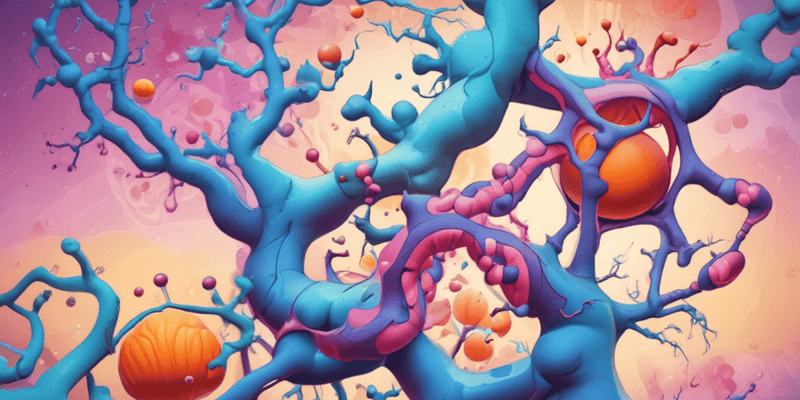Podcast
Questions and Answers
What type of enzyme is hexokinase?
What type of enzyme is hexokinase?
What is the reaction catalyzed by hexokinase?
What is the reaction catalyzed by hexokinase?
What is the product formed when glucose reacts with ATP in the presence of hexokinase?
What is the product formed when glucose reacts with ATP in the presence of hexokinase?
What is the function of kinases in metabolism?
What is the function of kinases in metabolism?
Signup and view all the answers
What is the type of reaction catalyzed by thiolase?
What is the type of reaction catalyzed by thiolase?
Signup and view all the answers
What is the last step in the beta oxidation of fatty acids?
What is the last step in the beta oxidation of fatty acids?
Signup and view all the answers
What type of enzyme is pyrophosphatase?
What type of enzyme is pyrophosphatase?
Signup and view all the answers
Which phosphate group of ATP is transferred by either hexokinase or glucokinase?
Which phosphate group of ATP is transferred by either hexokinase or glucokinase?
Signup and view all the answers
What is the type of inhibition that occurs when the inhibitor binds to the active site of the enzyme?
What is the type of inhibition that occurs when the inhibitor binds to the active site of the enzyme?
Signup and view all the answers
What is the term for the process by which an enzyme is converted to its active form?
What is the term for the process by which an enzyme is converted to its active form?
Signup and view all the answers
What is the term for the molecules that assist enzymes in their catalytic activity?
What is the term for the molecules that assist enzymes in their catalytic activity?
Signup and view all the answers
What is the term for the plot used to analyze the kinetics of enzyme-catalyzed reactions?
What is the term for the plot used to analyze the kinetics of enzyme-catalyzed reactions?
Signup and view all the answers
What is the term for the process by which an enzyme's activity is regulated through the binding of a molecule to a site other than the active site?
What is the term for the process by which an enzyme's activity is regulated through the binding of a molecule to a site other than the active site?
Signup and view all the answers
What is the term for the molecules that are required for the activity of certain enzymes?
What is the term for the molecules that are required for the activity of certain enzymes?
Signup and view all the answers
What is the term for the specific binding of an enzyme to its substrate?
What is the term for the specific binding of an enzyme to its substrate?
Signup and view all the answers
What is the term for the energy required for an enzyme-catalyzed reaction to occur?
What is the term for the energy required for an enzyme-catalyzed reaction to occur?
Signup and view all the answers
What is the function of the active site on an enzyme?
What is the function of the active site on an enzyme?
Signup and view all the answers
Which of the following is NOT a type of functional group found on the surface of the active site?
Which of the following is NOT a type of functional group found on the surface of the active site?
Signup and view all the answers
What is the term for a molecule that binds to an enzyme and enhances its activity?
What is the term for a molecule that binds to an enzyme and enhances its activity?
Signup and view all the answers
What is the rate-limiting enzyme in the De Novo Synthesis of Fatty Acids?
What is the rate-limiting enzyme in the De Novo Synthesis of Fatty Acids?
Signup and view all the answers
What is the function of HMG CoA Reductase?
What is the function of HMG CoA Reductase?
Signup and view all the answers
What is the effect of insulin on HMG CoA Reductase activity?
What is the effect of insulin on HMG CoA Reductase activity?
Signup and view all the answers
What is the effect of statins on HMG CoA Reductase activity?
What is the effect of statins on HMG CoA Reductase activity?
Signup and view all the answers
What is the term for a molecule that binds to an allosteric site on an enzyme and affects its activity?
What is the term for a molecule that binds to an allosteric site on an enzyme and affects its activity?
Signup and view all the answers
What is the function of acetylcholinesterase?
What is the function of acetylcholinesterase?
Signup and view all the answers
What is the ring structure of penicillin?
What is the ring structure of penicillin?
Signup and view all the answers
What is the target of penicillin in bacteria?
What is the target of penicillin in bacteria?
Signup and view all the answers
What is the result of penicillin binding to glycopeptide transpeptidase?
What is the result of penicillin binding to glycopeptide transpeptidase?
Signup and view all the answers
What is the type of inhibition exhibited by penicillin?
What is the type of inhibition exhibited by penicillin?
Signup and view all the answers
What is the basis for the antibacterial activity of penicillins?
What is the basis for the antibacterial activity of penicillins?
Signup and view all the answers
What is the name of the enzyme described in the text as responsible for the synthesis of bacterial cell wall?
What is the name of the enzyme described in the text as responsible for the synthesis of bacterial cell wall?
Signup and view all the answers
What is the term used to describe penicillin's structural similarity to the transition state?
What is the term used to describe penicillin's structural similarity to the transition state?
Signup and view all the answers
What is the role of cofactors in enzyme-catalyzed reactions?
What is the role of cofactors in enzyme-catalyzed reactions?
Signup and view all the answers
What happens to the reaction velocity when substrate concentration increases?
What happens to the reaction velocity when substrate concentration increases?
Signup and view all the answers
Why does the reaction velocity decrease after reaching the maximal velocity?
Why does the reaction velocity decrease after reaching the maximal velocity?
Signup and view all the answers
What is the significance of enzyme levels in clinical diagnosis?
What is the significance of enzyme levels in clinical diagnosis?
Signup and view all the answers
What happens to enzyme levels during cell necrosis due to disease or trauma?
What happens to enzyme levels during cell necrosis due to disease or trauma?
Signup and view all the answers
Which of the following tissues can be diagnosed using enzyme levels?
Which of the following tissues can be diagnosed using enzyme levels?
Signup and view all the answers
What is the primary function of enzymes in clinical diagnosis?
What is the primary function of enzymes in clinical diagnosis?
Signup and view all the answers
Why are enzymes released into the blood during normal cell turnover?
Why are enzymes released into the blood during normal cell turnover?
Signup and view all the answers
What is the relationship between substrate concentration and enzyme activity?
What is the relationship between substrate concentration and enzyme activity?
Signup and view all the answers
Study Notes
Enzyme Kinetics
- Michaelis-Menten kinetics describes the rate of enzymatic reactions, characterized by parameters like Vmax and Km.
- The Lineweaver-Burk plot is a double reciprocal representation of the Michaelis-Menten equation, useful for calculating Vmax and Km.
- Enzyme kinetics can be affected by various factors such as temperature, pH, and substrate concentration.
Coenzymes and Metal Ions
- Coenzymes are organic molecules (e.g., NAD+, NADP+, Biotin, Thiamine, Flavin Adenine Dinucleotide) that assist enzymes by participating in the chemical transformations of substrates.
- Metal ions like K+, Fe²⁺, Mg²⁺, and Zn²⁺ serve as cofactors to enhance enzymatic activity and maintain enzyme structure.
Types of Enzyme Inhibition
- Competitive inhibition occurs when a substrate and inhibitor compete for the active site of an enzyme.
- Non-competitive inhibition reduces enzyme activity without affecting substrate binding.
- Irreversible inhibition leads to permanent loss of enzyme activity, often via covalent bonding.
- Allosteric sites modulate enzyme activity by causing conformational changes, impacting substrate affinity.
Enzyme Activity and Regulation
- Enzymes lower activation energy, thus increasing reaction rates.
- Feedback inhibition regulates enzyme activity, where the end product of a pathway inhibits an upstream process.
- Allosteric regulation can be positive or negative and can significantly affect the rate-limiting step in metabolic pathways.
Enzyme Specificity
- Enzyme specificity refers to the ability of an enzyme to select substrate molecules based on shape, charge, or hydrophobic/hydrophilic characteristics.
- Lock and Key Model and Induced Fit Model explain how substrates bind to enzymes, influencing reaction rates.
Enzymes in Clinical Diagnosis
- Certain enzymes are released into the blood during normal cell turnover and can indicate tissue health.
- Elevated enzyme levels in the blood can be markers for diseases, particularly in organs such as the heart and liver.
Cardiac Enzymes as Diagnostic Markers
- Cardiac enzymes are utilized as biomarkers to diagnose myocardial infarction and other heart conditions.
- Key cardiac enzymes include creatine kinase (CK) and troponin.
Key Reactions Involving Enzymes
- Kinases transfer phosphate groups from ATP to specific substrates, crucial in metabolic regulation.
- Hexokinase and glucokinase phosphorylate glucose in glycolysis, a vital metabolic pathway, resulting in glucose-6-phosphate.
- Thiolase catalyzes the cleavage of beta-ketoacyl-CoA, a step in fatty acid metabolism, producing acetyl-CoA.
Penicillin and Enzyme Interactions
- Penicillin inhibits bacterial cell wall synthesis by irreversibly binding to glycopeptide transpeptidase, a serine protease, disrupting bacterial growth.
- Acetylcholinesterase hydrolyzes acetylcholine, a neurotransmitter, using serine residues to form a covalent intermediate.
Factors Affecting Enzyme Activity
- Temperature and pH can significantly influence enzyme activity, with each enzyme having optimal conditions.
- Substrate concentration impacts reaction velocity, which increases with substrate availability until Vmax is achieved, at which point all enzyme active sites are occupied.
Studying That Suits You
Use AI to generate personalized quizzes and flashcards to suit your learning preferences.




